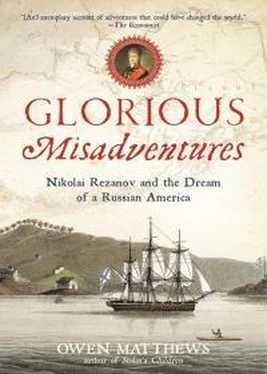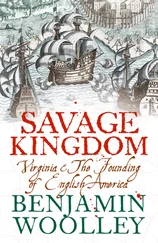Unlike the feudal nobility of Western Europe, who held land in their own right, Russian noblemen were first and foremost personal servants of the tsar. They were called namestniki , literally ‘placed men’ and given lands and vassals to support them and their families, but their lands remained the property of the tsar. In this, as well as in its court dress, arms and armour and diplomatic customs,12 the Muscovite court closely resembled the khanates it had deposed. Murat Demir Reza’s switch from Tatar lord to Muscovite nobleman was an easy one. The Rezanovs, Russianized and baptized into Orthodoxy within a generation, became loyal and energetic servants of the tsars.
In 1697 Tsar Peter I – later known as the Great – embarked on an eighteen-month incognito expedition to Holland and England during which he personally learned many useful skills, including tooth-pulling, shipbuilding and woodturning. The twenty-five-year-old tsar also discovered many wonders of Western technology. One was the wheelbarrow, in which, when drunk, Peter and his companions used to push each other into the prize holly hedges of Sayes Court, the Deptford house they rented from the diarist John Evelyn. (After the royal party had left the King’s Surveyor Sir Christopher Wren was called in to repair the damage to the gardens, while Charles II picked up the £350 bill for his Russian guests’ rampages.13) More importantly, Peter’s new interest in all things modern, from fire hoses and lepidoptery to city planning and astrology, inspired him to unleash a cultural revolution on his backward homeland.
On his return Peter began his reforms with the nobility, banning arranged marriages, Tatar-style kaftans and tall hats and imposing a tax on those boyars who refused to shave their beards in the Western manner. Peter’s modern ideas, however, did not extend to political reform. He saw the nobility as servants of the state and agents of his royal will. In the final years of his reign Peter codified the strata of the Russian bureaucracy, army and court in a unified table of ranks. The idea was to create an educated class of noble bureaucrats, with each of the fourteen ranks corresponding to an order of nobility. Thus up-and-coming men – not to mention flocks of ambitious foreigners – could join the nobility by virtue of their service to the state. Some of the hereditary nobility, primarily from old Muscovite families allied with Peter’s estranged first wife, attempted to resist and were soon marginalized. Newer, more opportunistic families like the Rezanovs quickly saw that they had much to gain from Peter’s revolution, and remade themselves in the image of the new age.
Gavriil Andreyevich Rezanov, grandfather to Nikolai, was born in 1699 and brought up as the ideal Petrine man. War, engineering and shipping were the growth industries of Peter’s Russia, and the young Gavriil mastered geometry, mathematics, engineering and shipbuilding and was one of the early residents of Peter’s new city on the Neva. By 1723 Gavriil Rezanov was working as an engineer on one of the Tsar’s pet projects, a seventy-two-mile canal intended to ease navigation between the Volga to the Baltic by bypassing the stormy Lake Ladoga.
The Ladoga Canal was a classic Petrine project: faddishly scientific and technically ambitious, with its double locks and reinforced banks. But despite its Western and progressive conception the plan was executed by the slave labour of thousands of conscript soldiers and state-owned peasants. The canal was also – not unlike St Petersburg itself – more about vanity than utility, since its one-metre depth allowed only shallow-draught barges to pass along it. Within a generation it was abandoned in favour of a deeper parallel canal, and today the old waterway survives only as a picturesque weed-filled ditch cutting through the dacha-lands on the lake’s southern shore.
Gavriil Rezanov’s superior on the Ladoga project was Burkhard Christoph von Münnich, a Danish-born soldier and engineer. Like many of the foreign military adventurers who came to Peter’s court, Münnich spent Russian lives freely in pursuit of his own ambitions. Nonetheless, Gavriil Rezanov thrived under this martinet, and by the time the canal was finally completed in 1730 Rezanov was Münnich’s deputy in charge of construction. The Dane was to be a useful patron. On Peter the Great’s death in 1725, his widow – crowned Empress Catherine I – appointed Münnich général en chef , the highest rank in the Russian army. The Dane went on to open Russia’s first engineering school and formally founded the Izmailovsky Life Guard Regiment. When the Empress Anna – Peter the Great’s niece and the second of the four empresses who ruled Russia in the eighteenth century – came to the throne in 1730, it was General Münnich who was instrumental in fulfilling her ambition to push Russian power deep into Europe.14
Münnich’s campaigns were a rehearsal in miniature for the Russian Empire’s even greater conquests under Catherine the Great. He besieged the East Prussian port of Danzig, allowing Russia to install the first of several puppet kings of Poland in 1736. Then he took his new Izmailovsky Guards south for the first of a series of campaigns against the Tatar Khanate of Crimea, the final outpost of the Golden Horde. Major Gavriil Rezanov was one of many aristocratic officers of Tatar origin to march with him against his former kinsmen. A fellow officer was Baron Hieronymus von Münchhausen, whose tall tales of the siege of the Turkish fortress of Özi and other ‘Marvellous Travels and Campaigns in Russia’ became a comedy classic when written up by an anonymous parodist and published in 1781 as The Surprising Adventures of Baron Münchhausen .
But Russia’s fortunes – and Rezanov’s – really took off with the outbreak of the Seven Years’ War in 1757. Sparked by a colonial skirmish between British and French forces in Pennsylvania, this conflict was in many senses the true first world war. It was fought by at least fifteen European powers and principalities, with hostilities extending from Canada to India to the Philippines. Up to 1,400,000 people are believed to have been killed across the globe as a result of the prolonged hostilities, which destroyed many fledgling colonies and beggared swathes of Central Europe.15
Russia managed to escape becoming deeply embroiled in the upheavals, but even its peripheral involvement in the Seven Years’ War was to have a profound impact on its standing as a European empire and naval power. Empress Elizabeth I – Peter’s feisty daughter, who had seized power in 1741* – began with an opportunistic land grab, ordering her armies to seize the Baltic provinces of East Prussia while Prussia’s king, Frederick the Great, was busy attacking Bohemia. In 1760 Elizabeth’s troops seized Berlin.* Russia soon retreated from Berlin but retained Königsberg, capital of East Prussia and ancient coronation place of Prussia’s kings. The loss of Königsberg to the Russians marked the definitive arrival of a powerful and unpredictable new player in the politics of central Europe. And Gavriil Rezanov, now a lieutenant general and decorated war hero, was appointed Königsberg’s first Russian commandant.
Gavriil Rezanov probably first met Gavriil Okunev at the Admiralty in St Petersburg, a 400-yard-long complex of offices, rope-walks, dry docks and sawpits on the southern bank of the Neva next to the newly built Winter Palace. Major General Okunev, a nobleman from Pskov and a talented shipwright, had in 1746 been appointed head of Russia’s shipbuilding on the Baltic, which after the seizure of Königsburg became centred in the old Prussian port of Pillau. So Okunev and Rezanov had much business to transact together.
Besides a professional interest in Baltic shipping, the two Gavriils had much else in common. They were both born in 1699; they were military men who owed their position to the Seven Years’ War, and their families had both been ennobled by Ivan the Terrible – the Okunevs nine years before the Rezanovs.16 They were also close neighbours in St Petersburg. Okunev lived at 2 Dvoryanskaya Street, on the Admiralty Canal, around the corner from the Rezanovs on the Neva Embankment. In terms of status Rezanov was the senior man, third in Peter the Great’s table of ranks; Okunev was, however, richer, thanks to extensive family estates around Pskov. All in all the men were well matched, financially and socially, and it was entirely natural that the two generals should eventually arrange a marriage between their children, Rezanov’s son Pyotr, a young guardsman of the Izmailovsky Regiment, and Okunev’s daughter Alexandra. In 1763 the couple’s first son, Nikolai Petrovich Rezanov, was born in St Petersburg.
Читать дальше












